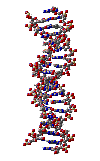|
Potential new treatment for Huntington and Parkinson patients: can inclusions bodies be good news for neurodegenerative diseases?
A potential new treatment for neurodegenerative disorders, which seems to be able to reduce the toxic protein aggregates characteristic of many of these diseases, is described online this week in the journal Proceedings of the National Academy of Sciences1. Since it is believed that in most neurodegenerative disorders, like Parkinson and Huntington’s disease (PD and HD respectively), abnormal protein aggregates are major culprits associated with neurodegeneration, this research may have important implications for the lives of thousands of neurodegenerative patients all over the world.
Parkinson’s and Huntington’s diseases are incurable devastating brain disorders that result from the death of brain cells associated with muscle control. Both illnesses, like many other neurodegenerative diseases, result from the formation of misshaped/incorrectly folded versions of normal proteins (all proteins have a specific shape/folding associated with their normal function) that tend to clump together leading to the death of the cells in the neighbourhood.
But the formation of these abnormal proteins is usually not a problem as two effective mechanisms exist to eliminate them: proteasomes, which are multi-protein complexes capable of digesting/cutting the toxic proteins into small pieces to be easily disposed and molecular chaperones, proteins capable of assisting other proteins to “move” into their correct shape/fold. In the cases where abnormal proteins are allowed to accumulate, as it happens in many neurodegenerative diseases, it is believed that these protective systems are malfunctioning. The fact that HD patients are known to have problems with faulty proteasomes supports this hypothesis.
Furthermore, cells with high accumulation of misshaped proteins, including those from PD and HD patients, can also present a cellular structure called inclusion body, which is known to accumulate high quantities of the altered aggregated protein. The role of these inclusions is not clear, and while for a long time they were believed to be toxic and part of the disease process, in recent years, this has been challenged and some researchers now believe that inclusion bodies (also called inclusions) might have a role eliminating the aggregates of toxic proteins. The fact that inclusion bodies are known to contain high quantities of proteasomes further supports this hypothesis. Nevertheless, research in therapies for neurodegenerative diseases seems to continue orientated towards drugs capable of diminish these cellular structures
But Ruth A. Bodner, Tiago Fleming Outeiro, a Portuguese scientist, Aleksey G. Kazantsev and colleagues from the Center for Cancer Research, Massachusetts Institute of Technology, Cambridge and the Mass General Institute for Neurodegenerative Disease, Massachusetts General Hospital, and Harvard Medical School, US had a different idea.
In fact, although much research has been done on compounds capable of diminish the number of inclusions in cells with neurodegenerative mechanisms so far the results have been inconclusive. This observation, together with the emerging believe that inclusions might actually be involved in cells’ protection, made Bodner, Outeiro, Kazantsev and colleagues decide to look instead at substances known to increase the number of inclusions, analysing their effect on neurodegenerative mechanisms. For that they used cellular models of PD and HD consisting of cells, growing in laboratory, which are induced to produce toxic quantities of the protein associated with each of the diseases.
As expected, Bodner, Outeiro, Kazantsev and colleagues found that the compounds that increased the amount of misshaped protein also induced the formation of cellular inclusions. But, more interestingly, was the fact that among those substances that increased inclusions’ numbers, a few were able to revert (and very efficiently) some of the harmful effects induced by the toxic aggregates of misshaped proteins.
In fact, in the cellular model of HD some of the tested substances were able to recover proteasome function - which is crucial to eliminate abnormal proteins in the cells and is known to be defective in HD – while in the PD model the tested substances were capable of diminish the toxicity of the misshaped proteins associated with disease and, in consequence, also cellular death. Furthermore, these beneficial effects correlated directly with the number of inclusions formed, further supporting the idea that inclusions bodies are not necessarily part of the disease, but instead a coing mechanism.
Bodner, Outeiro, Kazantsev and colleagues also had two other very interesting findings. Firstly, the remarkable effectiveness of the substances tested - the most effective compound was able to recover up to 39% of proteasome function in the HD model, while reducing 46% the toxicity associated with the protein aggregates in the model of PD – what raises hopes that these substances might become important new drugs. Secondly, the identification of specific atoms in the tested substances, that, when changed, reduced drastically the substances’ effectiveness. This last observation raises the possibility that different changes in the already identified areas, might, instead, be able to increase even more the effectiveness of the potential drugs.
At the moment the treatments available for neurodegenerative patients are only able to treat the individual symptoms but not the disease. What Bodner, Outeiro, Kazantsev and colleagues’ research might mean is that one day we will be able to delay, or even revert, disease symptoms, giving patients the possibility of enjoying for longer the pleasure of a normal life. Although much more research is necessary in order to confirm these results, Bodner, Outeiro, Kazantsev and colleagues’ new work is undoubtedly exciting news for neurodegenerative patients all over the world.
Piece researched and written by: Catarina Amorim ( catarina.amorim@linacre.ox.ac.uk)

1 Proceedings of the National Academy of Sciences – online edition 7th March 2006
" Pharmacological promotion of inclusion formation: A therapeutic approach for Huntington’s and
Parkinson’s diseases”
Original paper’s authors
Link to the original paper
|
In collaboration with the Observatório da Ciência e do Ensino Superior (OCES)
Financed by the Fundação para a Ciência e Tecnologia (FCT) |





